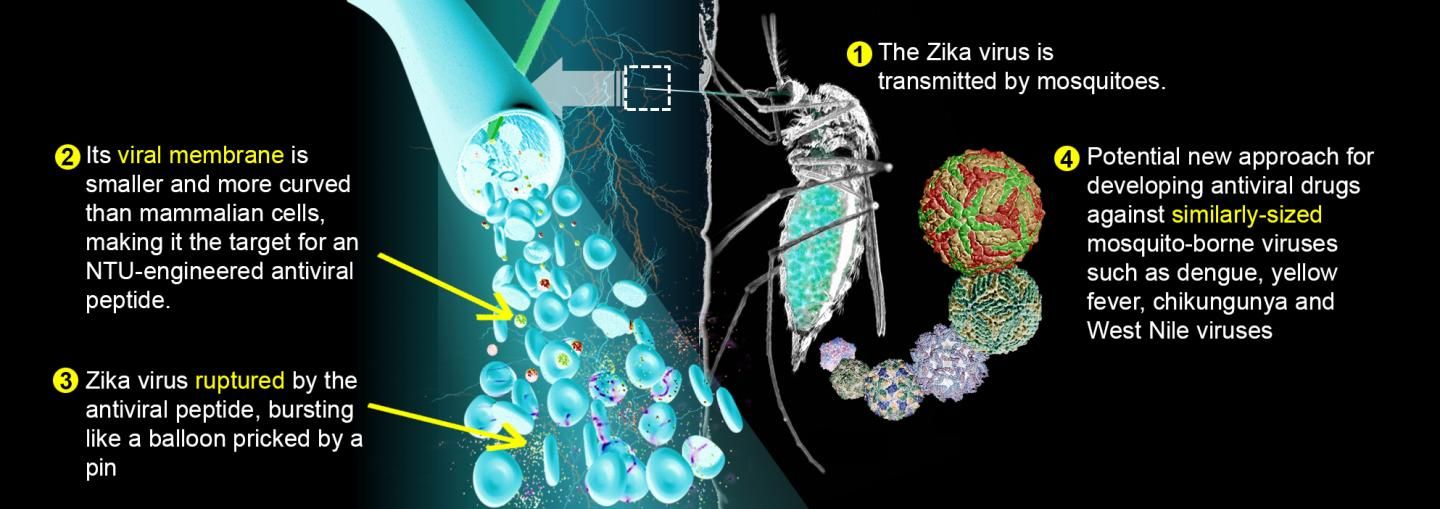Engineered Peptide Successfully Exploits Achilles' Heel of Zika Virus

Scientists at Nanyang Technological University, Singapore (NTU Singapore) have engineered an antiviral peptide that exploits the Zika virus at its Achilles' heel - the viral membrane - hence stopping the virus from causing severe infections.
This new method of attacking the viral membrane focuses on directly stopping Zika virus particles rather than preventing the replication of new virus particles, and can potentially work against a wide range of membrane-enveloped viruses.
When administered in Zika-infected mice in the lab, the engineered peptide drug (a compound consisting of amino acids) reduced disease symptoms and the number of deaths. Importantly, the peptide was able to cross the nearly impenetrable blood-brain barrier to tackle viral infection in mouse brains and protect against Zika injury, a critical feature since Zika targets the brain and central nervous system.
The research team led by NTU Singapore's Associate Professor Nam-Joon Cho published their findings in the peer-reviewed journal Nature Materials on 22 October 2018.
The study, done in collaboration with the Federal University of Minas Gerais (UFMG) in Brazil and Ghent University in Belgium, spanned over six years and combined materials engineering, antiviral drug development, and pharmacology.
"There are currently no vaccines for the Zika virus, while available medicines only alleviate symptoms such as fever and pain," said Cho of NTU's School of Materials Science and Engineering. "This newly created peptide holds great promise in becoming a future antiviral drug that can act directly on viral infections in the brain."
The Zika virus is transmitted by Aedes mosquitoes and infections during pregnancy are linked to birth defects such as microcephaly, a condition in which a baby is born with an abnormally small head and brain. The World Health Organisation declared the Zika disease an international emergency in 2016, and it remains a large threat globally today.
In 2004, Cho developed the first antiviral peptide that works against viral membranes in laboratory tests. Since then, NTU scientists have studied how antiviral peptides can create pores that form in membranes made up of two layers of lipids (a component of fats).
Over the years, the team studied the peptide's interactions with lipid membranes and engineered new peptides with greater potency and improved pharmacological properties. These findings led them to test a particularly promising peptide in Zika-infected mice and also showed that it ruptured other similar-sized enveloped viruses in the laboratory, such as dengue and chikungunya.
"The peptide differentiates between Zika viral membranes and mammalian cell membranes because the virus particles are much smaller and more curved, while the mammalian cells are larger and flatter. Like how a pin pricks a balloon, the peptide pricks a hole in the viral membrane. Prick enough holes, and the virus will be ruptured," said Cho.
Lab tests showed that when the peptide was administered, 10 out of 12 infected mice survived. In comparison, all the mice in the control group died within a week post-infection. In addition, therapeutic concentrations of the peptide were able to cross the blood-brain-barrier, allowing it to inhibit viral infection in the brain.
"The exciting antiviral results validate the potential of this innovative therapeutic strategy and are further enhanced by the engineered peptide's ability to cross the blood-brain barrier," said Jeffrey S. Glenn, a Professor of Medicine and Microbiology & Immunology at Stanford University, who is not part of the study. Glenn is also a former member of the FDA Antiviral Drugs Advisory Committee.
In general, most antiviral drugs target the replication process of viruses. However, viruses often mutate quickly and antiviral drugs that target viral replication can become obsolete. Attacking the physical structure of enveloped viruses is a new approach to developing antiviral drugs. It offers promise for the peptide to be effective even if the Zika virus attempts to mutate.
Cho said, "There are instances where a virus mutation can lead to an epidemic in a short time, leaving communities unprepared. By targeting the lipid membrane of virus particles, scientists may devise more robust and effective ways to stop viruses."
The Zika virus belongs to the Flaviviridae family and is related to other mosquito-borne viruses like dengue, chikungunya and yellow fever. As all flaviviruses have virus particles that are around 40-55 nanometres in diameter and are enveloped by a lipid membrane, the peptide engineered by the scientists from NTU Singapore has the potential to work against these viruses too.
Laboratory tests in this study confirm this potential and in future, the research team intends to study the effects of the peptide on diseases caused by these other viruses in greater detail. The team will also conduct trials in larger animals, and subsequently will plan to initiate human clinical trials, once relevant preclinical studies are completed and regulatory approvals obtained.
"This work represents a paradigm-changing breakthrough in the field of antiviral drug design," commented professor William C. Wimley, an antimicrobial peptide expert from Tulane University in the United States, who is not part of the study. "It shows how the viral envelope, a novel target in antiviral drug design, can specifically be targeted by a peptide. It also shows that a peptide targeting the viral envelope can effectively inhibit virus in the body, and even in the brain, an organ that actively excludes many therapeutics. Given the vast potential of peptides as antibacterial and antifungal agents, this may be a game-changing discovery that will be broadly applicable to the design of anti-infective drugs against many classes of pathogens."
Related antiviral technologies have been licensed from NTU Singapore to a local spin-off company, TSG Therapeutics Pte. Ltd., as part of plans to spur clinical translation. Cho is co-founder of TSG Therapeutics.
Source: Nanyang Technological Universit